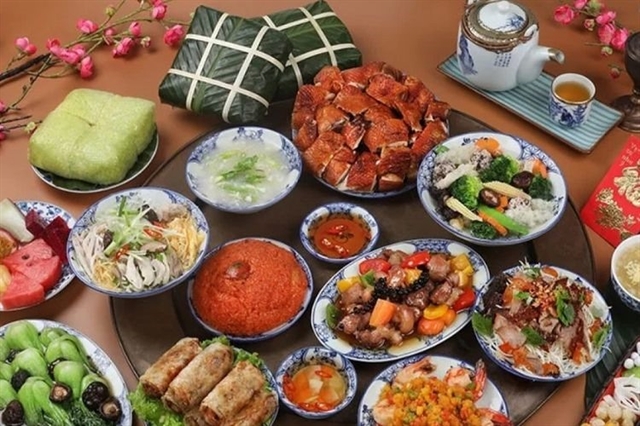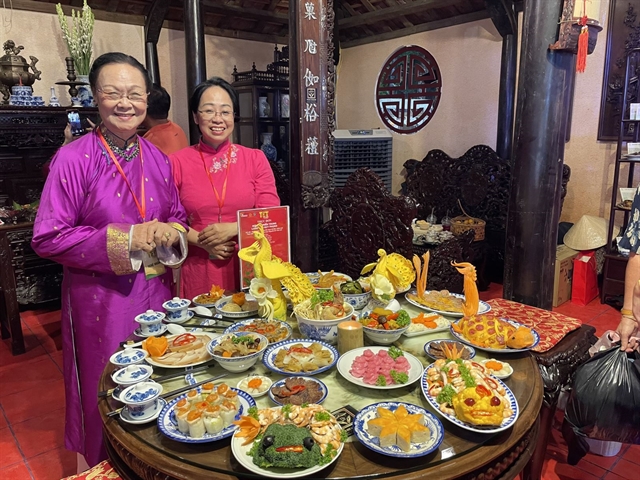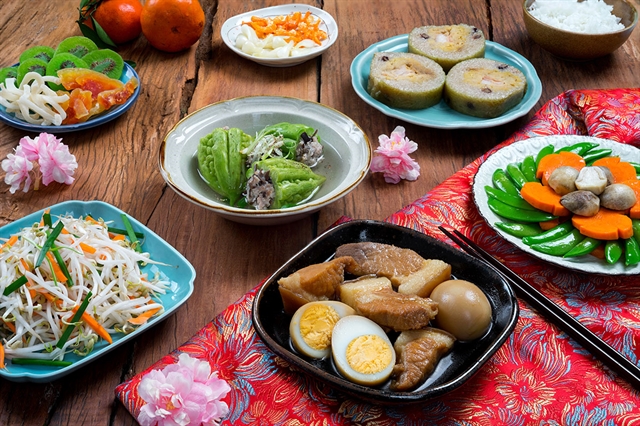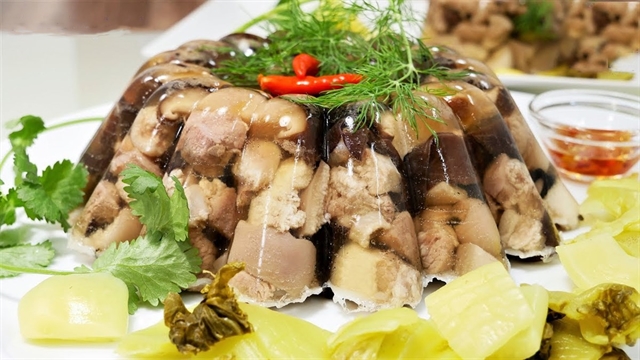Thanh Hà
The Vietnamese traditional Tết holiday (Lunar New Year), the biggest and most important festival, is fast approaching.
Households, particularly women, are carefully preparing things to cook and offer a full tray of traditional dishes to remember to their ancestors, so that they will bless their children and grandchildren with good health, success and keep close family bonds and help them stay safe.
“The Tết tray is not a genuine and long-term culture of Vietnamese but it still consists of deep spiritual value, a lively reflection of the habits of the country’s three regions,” said Master Chef Phạm Tuấn Hải.

A tray of Tết dishes cooked by homes in the north. Photo fptshop.com.vn
Traditional dishes include square glutinous rice cake (locally known as bánh chưng), round glutinous rice cake (or bánh tét), boiled chicken, steamed momordica glutinous rice (xôi gấc), a rustic soup (or canh bóng thả), bamboo soup stewed with pig’s trotters (canh măng), braised pork and eggs, frozen pork or pig legs, along with pickled onions and many others, said Hải, adding that these dishes not only carry their own unique characteristics, but also provide households with their own rich cultural heritage connecting to each family from generation to generation.
“In fact, each of these traditional dishes tells its own story. It holds memories of home and cozy family dinners, where everyone gathers to share joy and sorrow. These dishes also evoke emotions and reminds family members the importance of family ties and connections in life,” Hải told Việt Nam News.

A tray of Tết dishes in the central region often include fermented sour pork, dried bamboo fried with chicken organs and dưa món - a mix of brined vegetables that is ubiquitously found on tables of feasting Vietnamese families during Lunar New Year celebrations. Photo baotintuc.vn
A tray of Tết dishes in the north often includes four bowls and four plates in addition to a plate of bánh chưng and pickled onions. The bowls are stewed pig leg with bamboo, mixed pork rind soup, arrowroot vermicelli soup, minced pork and mushroom soup. The four plates are boiled chicken, frozen pork meat, pork paste and a plate of fried spring rolls, Hải said, noting that richer families often cook their Tết tray with six bowls and six plates. In addition, many northern localities cook braised fish with galangal root and fried almonds.
A tray of Tết dishes in the central region is again often slightly different and can offer some other dishes. They include stewed pig leg, field fish soup, stewed chicken with lotus seeds, daylily soup with vermicelli, shrimp and pork, fried spring rolls, rotisserie chicken, braised shrimp with pork, boiled pork and shredded chicken.

Bitter melon (known as khổ qua, meaning misery is over), a plate in the middle of the tray, is an indispensable dish in the southern Tết dish tray. Photo ivivu.com
Others include fermented sour pork, dried bamboo fried with chicken giblets and dưa món, a mix of brined vegetables that is ubiquitously found on tables of feasting Vietnamese families during Lunar New Year celebrations. It's commonly eaten with traditional bánh chưng and bánh tét, but can also be used as a vegetable side for a meat entrée, said Hải.
He said a tray of Tết dishes in the southern region tend to be more rustic, without fussy cooked and decoration. Southerners often used natural ingredients for cooking. Indispensable dishes are round glutinous rice cake, eaten with mixed sour and sweet carrot and radish salad, pork and duck eggs braised with coconut juice, eaten with green bean sour salad, boiled pork dipped in fish sauce, fresh pork sausage, pork skin threads salad, pork and shimp rolls and bitter melon.

Jellied pork meat, one of main Tết dishes of northern housewives. Photo dieenmayxanh.com
Southwestern people often cook sour field fish with tomato hotpot, eaten with natural herbs. “This dish isn't used to worship on the altar, but as an invitation for guests arriving for Lunar New Year greetings,” said Hải, adding that the soup is also a good taste contrast against some of the heavier dishes.
Hải said he has received orders to cook vegetarian Tết dishes for many locals and overseas Vietnamese returning to the country to welcome in the holidays. VNS